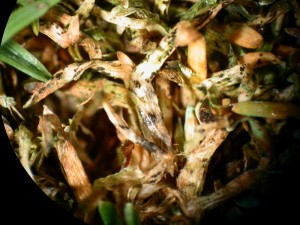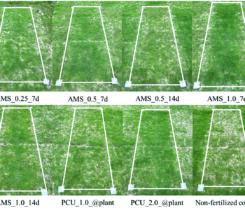Spoon-feed N now to beat anthracnose

Basal rot anthracnose is a serious problem on Poa annua./ Courtesy The Ohio State University Buckeye Turf
The best way to beat anthracnose is to give greens a good, healthy dose of N in the Spring to get growth and fertility levels up and then continue to maintain fertility with a spoon-feeding program, says James Murphy, Ph.D., extension turf specialist at Rutgers University. But there are things a superintendent can do now to eliminate the need for a slug of N next year.
“That heavy dose is only for catch-up,” Murphy says. Since it is too late to do the Spring dose for this year, he would recommend a strategy built on a spoon-feeding program throughout the rest of the season to get fertility up and then, if there still is a deficiency, remedying it next Spring. Of course, it is not a good idea to over-fertilize and get too much growth that will interfere with playability.
“If you are behind the 8-ball, Spring is the best time to treat this,” Murphy says.
That big dose should consist of one-half pound of N – or, perhaps, a full pound of slow-release material.
“The most important thing is to get a better understanding of fertilizer N,” Murphy continues. “Fertility goes a long way toward controlling anthracnose.” A steady spoon-feeding from now into the Fall coupled with soil testing will position a superintendent for next year. In fact, a good, regular spoon-feeding may even eliminate the need for a big dose next season.
Murphy and Bruce B. Clark, Ph.D., recently got a two-year grant from the GCSA of New Jersey to study the influence of best management practices, like N fertility, on anthracnose disease control of annual bluegrass turf. The problem is much more a problem on Poa than it is on bent.
While there are new varieties that are resistant to anthracnose, the option of re-grassing greens is not one most superintendents have. Since bluegrass is much more anthracnose-prone, seeding to creeping bent is a good option where available.
Rutgers also is looking at potassium and pH as factors. Right now, it appears potassium plays an important role in managing anthracnose. The role of pH is less clear.











